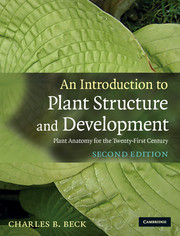Book contents
- Frontmatter
- Contents
- Preface to the second edition
- Preface
- Acknowledgements
- General references
- Chapter 1 Problems of adaptation to a terrestrial environment
- Chapter 2 An overview of plant structure and development
- Chapter 3 The protoplast of the eukaryotic cell
- Chapter 4 Structure and development of the cell wall
- Chapter 5 Meristems of the shoot and their role in plant growth and development
- Chapter 6 Morphology and development of the primary vascular system of the stem
- Chapter 7 Sympodial systems and patterns of nodal anatomy
- Chapter 8 The epidermis
- Chapter 9 The origin of secondary tissue systems and the effect of their formation on the primary body in seed plants
- Chapter 10 The vascular cambium: structure and function
- Chapter 11 Secondary xylem
- Chapter 12 The phloem
- Chapter 13 Periderm, rhytidome, and the nature of bark
- Chapter 14 Unusual features of structure and development in stems and roots
- Chapter 15 Secretion in plants
- Chapter 16 The root
- Chapter 17 The leaf
- Chapter 18 Reproduction and the origin of the sporophyte
- Glossary
- Index
- References
Chapter 3 - The protoplast of the eukaryotic cell
Published online by Cambridge University Press: 05 June 2012
- Frontmatter
- Contents
- Preface to the second edition
- Preface
- Acknowledgements
- General references
- Chapter 1 Problems of adaptation to a terrestrial environment
- Chapter 2 An overview of plant structure and development
- Chapter 3 The protoplast of the eukaryotic cell
- Chapter 4 Structure and development of the cell wall
- Chapter 5 Meristems of the shoot and their role in plant growth and development
- Chapter 6 Morphology and development of the primary vascular system of the stem
- Chapter 7 Sympodial systems and patterns of nodal anatomy
- Chapter 8 The epidermis
- Chapter 9 The origin of secondary tissue systems and the effect of their formation on the primary body in seed plants
- Chapter 10 The vascular cambium: structure and function
- Chapter 11 Secondary xylem
- Chapter 12 The phloem
- Chapter 13 Periderm, rhytidome, and the nature of bark
- Chapter 14 Unusual features of structure and development in stems and roots
- Chapter 15 Secretion in plants
- Chapter 16 The root
- Chapter 17 The leaf
- Chapter 18 Reproduction and the origin of the sporophyte
- Glossary
- Index
- References
Summary
Perspective
The eukaryotic cell is composed, with a few exceptions, of both a living protoplast, the site of cellular metabolism, and an enclosing cellulosic wall of one or more layers (Fig. 3.1). While not alive as a structural unit, the wall is commonly traversed by living components, plasmodesmata, which connect adjacent protoplasts and thus facilitate communication between, and the integration of, cells within a tissue. All plant cells possess a protoplast during development, and in many it persists throughout the life of the plant. Some cells, however, do not achieve their ultimate functional state until the protoplast dies as, for example, a specialized water-conducting cell such as a vessel member.
The protoplasts of all plant cells are basically similar, but may differ in relation to the function of the mature cells. For example, the protoplast of a parenchyma cell in the outer cortex or in a leaf will contain many chloroplasts since a major function of these cells is photosynthesis. In contrast, a cell of the pith (a storage region) in the center of the stem may lack chloroplasts but will contain unpigmented plastids in which starch is synthesized (amyloplasts). The protoplast of an immature vessel member, however, destined to die, may contain no plastids at all, or plastids of a highly modified type.
Each cell protoplast is characterized by the potential for the development of an entire organism (see Steward et al., 1964). This total potentiality is, however, rarely achieved under normal conditions.
- Type
- Chapter
- Information
- An Introduction to Plant Structure and DevelopmentPlant Anatomy for the Twenty-First Century, pp. 38 - 57Publisher: Cambridge University PressPrint publication year: 2010



